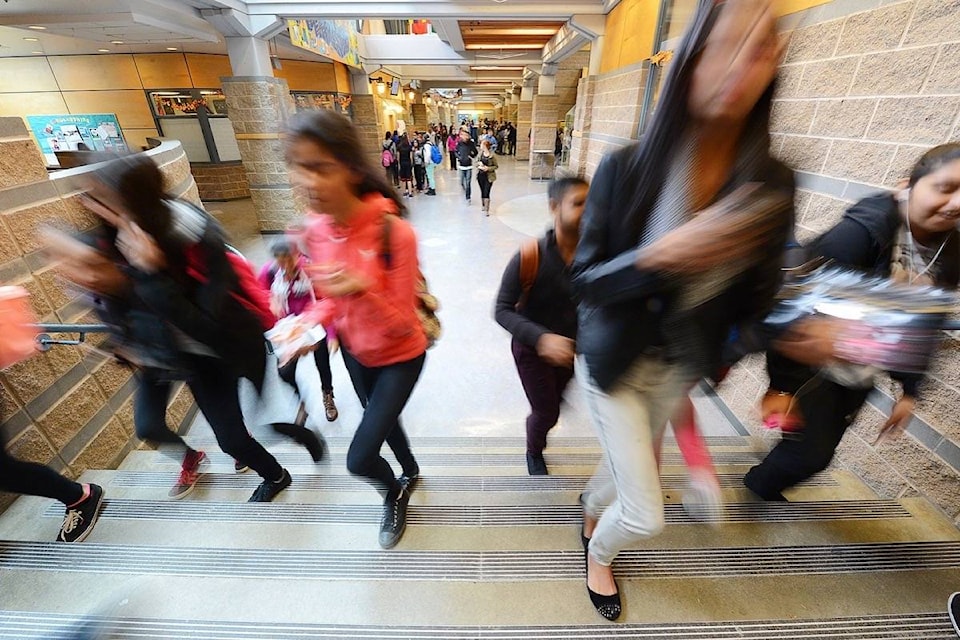More support, better relationships and more funding are among the recommendations in a report released Thursday by B.C. children’s watchdog that looked at youth in foster care do in school.
Bernard Richard, the representative for children and youth, looked at education outcomes for kids and teens still in care and those who have already aged out of the system, including test scores and graduation rates.
Graduation rates have gone up by 10 per cent between 2012/13 and 2014/15, but that rate still lags behind those for youth not in care.
Only half of youth in care graduated high school within six years of starting Grade 8 in the 2014/15 school year, compared to almost 90 per cent of students not in care.
Richard warned that recent improvements to the youth in care graduation rate are beginning to stagnate, based on/according to 2015/16 education ministry figures.
“If the overall graduation rate in B.C. dipped below 51 per cent… protests would break out across the province and rightly so,” said Richard. “Students in care are not naturally underperformers but because of their life circumstances many need extra supports to succeed academically.”
As for test results, fewer youth in care met or exceeded expectations on their Foundational Skills Assessments tests than did kids not in foster care, the report said, though it cautioned against stereotyping these kids as “underperformers.”
Those supports, Richard said, “are often not available.”
In response to the report, education minister Rob Fleming laid the blame at the feet of the past Liberal government.
He pointed to two recent initiatives that he said will turn the trend of poor outcomes around: the province’s recent decision to waive tuition fees for youth in care and the “largest hiring of new teachers in generations.”
Big portion of kids in foster care are indigenous: report
The report’s recommendations put a heavy focus on ensuring that Indigenous youth in care were kept with Indigenous families and that their elders and staff were present in schools.
Slightly more than two thirds of students in care were Indigenous, the report said, and statistically, Indigenous youth in care performed worse than their non-Indigenous counterparts.
.@RCYBC report finds many more Indigenous kids in care than non-Indigenous. Finds big edu achievement gaps bw those in care vs not in care pic.twitter.com/YZSkL8yOxD
— Kat (@katslepian) October 26, 2017
Only 44 per cent of Indigenous youth in care graduated within six years of starting Grade 8, compared to 61 per cent of non-Indigenous students in care.
Currently, each Indigenous child comes with an extra $5,000 in funding that is pooled at the school district level and used to fund culturally-sensitive education initiatives.
Richard said that while initiatives like free post-secondary education for Indigenous students are great, they’re not having the effect they could be.
“If you graduate at a rate of 44 per cent, it’s wonderful to have an tuition waiver program but you can’t access it if you don’t graduate from school,” Richard said.
Fleming agreed.
“We’re not going to be able to utilize those kinds of tuition waivers and other supports into adulthood if we don’t get kids to be more successful in their school age years,” he said.
Stability is key: representative
Richard pointed to Alex Gervais as an example of why stable homes and schools are essential for success. Gervais, who committed suicide when he was 18 at an Abbotsford hotel in 2015, was moved 17 times over 11 years.
“If you’re a young person and you’re being changed from home to home and then quite possibly being moved from school to school it makes academic success for difficult,” Richard said.
A disconnect between social workers and foster parents contributes to poor outcomes and feelings of isolation at school for youth in care, Richard said.
Currently, youth in care need field trip permission slips to be signed by their social worker, not their foster parents.
“If you’re a teen and you’re already ostracized and labelled because you’re from the care system but then you can’t participate in school activities because your social worker can’t be reached… that’s a huge thing,” said Richard.
Fleming said the province was committed to making a youth’s in care school experience just like that of any other student.
“Where there are rules standing in the way that highlight that they’re different, lets get rid of those,” said Fleming.



